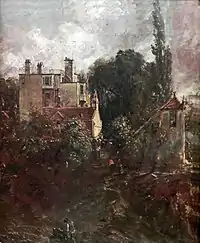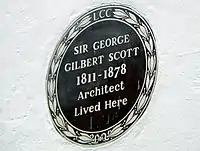Admiral's House, Hampstead
Admiral's House (originally known as Golden Spikes and later as The Grove)[1] is a Grade II listed house in Hampstead in the London Borough of Camden. The house's name is a misnomer, as no admirals have ever lived there.[2] The house is featured in multiple paintings by John Constable.[3]
| Admiral's House | |
|---|---|
.jpg.webp) Admiral's House in 2016 | |
| Former names |
|
| General information | |
| Status | Completed |
| Type | House |
| Classification | Grade II |
| Location | Hampstead, London Borough of Camden |
| Town or city | London |
| Country | United Kingdom |
| Coordinates | 51.5597°N 0.1801°W |
| Construction started | 1700 |
| Technical details | |
| Material | Stone brick |
History


The house was built in 1700 by Charles Keys.[1] The house was used as a masonic lodge between 1730 and 1745, which may have been why Keys named it Golden Spikes.[1] It appeared on John Rocque's Map of London, 1746.[4] Naval captain Fountain North owned the house between c. 1775 to 1811.[1] He renamed it The Grove[1] and added a quarterdeck to the roof of the house.[1][5][6] He also added bulwarks and portholes to the property, and in 1805, bought the nearby grove and demolished it to extend the house's garden.[1] In the late 18th century, the house was mistaken as belonging to Admiral Barton.[1][7]: 8 The problem arose because a print of The Grove was incorrectly entitled Admiral Barton’s Hampstead.[4] A possible explanation for the confusion was that Barton, who lived in Hampstead, fired cannon from his roof, and so it was assumed they were from the quarterdeck of The Grove.[1][7]: 8 As a result, the house became known as Admiral's House,[1][6] though no admiral has ever lived in the house.[7]: 8 [8] Admiral’s Walk, the road on which the house is situated, is similarly misnamed.[7]: 8 [6]
In the 19th century, John Constable painted Admiral's House a number of times.[1][5] One painting, The Grove, or Admiral's House, Hampstead, was bought by Hugo von Tschudi for the Berlin Alte Nationalgalerie,[9] was later on display at the Tate Britain,[10] and is now in the collections of the Victoria and Albert Museum in London.[6][11] The painting is believed to be the view of Admiral's House from Constable's nearby house.[11] Another painting, The Romantic House at Hampstead has been in the collections of the National Gallery.[12] George Gilbert Scott lived in the house between 1856 and 1865,[7]: 375 although he decided that Hampstead was too cold for him.[5] In 1910, London County Council commissioned a blue plaque for Scott on Admiral's House.[6][13]
From 1917 to 1926,[4] John and Winifred Fortescue lived at Admiral's House.[6] During his time in the house, John Fortescue wrote his multi-volume book Fortescue's History of the British Army.[12] The couple moved from Admiral's House to Windsor Castle.[12] In 1941, Norman Thomas Janes produced a watercolour painting of Admiral's House that is located in the V&A Museum collections.[14] Admiral's House is believed to have been an inspiration for P. L. Travers' Mary Poppins books.[15] Travers' character Admiral Boom likes to fire cannons, as did Admiral Barton, who at the time was believed to have lived at the house.[5][6] Scenes from the 1964 Mary Poppins film adaptation were filmed at Admiral's House.[16] which was used as Admiral Boom's house in the film.[17]
In 1950, the house was listed as a Grade II listed building.[4] In the 1960s and 1970s, the gardens of Admiral's House and the next door Grove Lodge were opened to the public on selected dates as part of the National Gardens Scheme.[18][19] In 1976, the brick and Portland stone boundary wall to the house was Grade II listed, in a separate listing from the main house, and including neighbouring properties.[20] In the late 20th century, windows were added to the roof, and the kitchen was extended. These changes were not included in the Grade II listing of the house.[4] Since the 1980s, Admiral's House has been owned by John Gardiner KC.[16]
Other buildings
In the 20th century, a wing of Admiral's House was converted into a separate house, named Grove House.[21] John Galsworthy lived at Grove House from 1918 to 1933.[16] In 2015, the owners of Grove House wanted to knock down part of the house to build an extension and 13 room basement.[16] In the 1920s, parts of the gardens of Admiral House's were sold as land for two additional houses.[4] Between 1931 and 1932, Edward Maufe built a studio next to the house.[1]
References
- Baker, T. F. T.; Bolton, Diane K.; Croot, Patricia E. C. (1989). Hampstead: Hampstead Town, in A History of the County of Middlesex. Vol. 9. Victoria County History. Archived from the original on 10 April 2020. Retrieved 8 April 2020 – via British History Online.
- "Admiral's House, Hampstead - Admiral Booms House In Mary Poppins". www.london-walking-tours.co.uk. Archived from the original on 4 June 2020. Retrieved 17 May 2020.
- "The Grove, or Admiral's House, Hampstead | John Constable | V&A Search the Collections". V and A Collections. 17 May 2020. Retrieved 17 May 2020.
- "Admiral's House". Historic England. Archived from the original on 1 June 2020. Retrieved 8 April 2020.
- Davies, Andrew (12 September 1995). "Site unseen / Admiral's House, Hampstead". The Independent. Archived from the original on 10 April 2020. Retrieved 8 April 2020.
- "The North London House That's Partly Shaped Like A Ship". Londonist. 12 June 2017. Archived from the original on 31 May 2020. Retrieved 8 April 2020.
- Hibbert, Christopher; Weinreb, Ben; Keay, Julia; Keay, John (2008). The London Encyclopaedia. Macmillan Publishers. ISBN 9781405049245. Archived from the original on 1 June 2020. Retrieved 8 April 2020.
- DK Eyewitness Travel Guide: London. DK. 2012. p. 230. ISBN 9781405393140. Archived from the original on 31 May 2020. Retrieved 8 April 2020.
- Keisch, Claude (2005). The Alte Nationalgalerie, Berlin. C.H. Beck. p. 73. ISBN 9783406526756. Archived from the original on 2 June 2020. Retrieved 8 April 2020.
- Bermingham, Ann (1989). Landscape and Ideology: The English Rustic Tradition, 1740-1860. University of California Press. pp. 155, 198, 232–33. ISBN 9780520066236. Archived from the original on 31 May 2020. Retrieved 8 April 2020.
- "The Grove, or Admiral's House, Hampstead". Victoria and Albert Museum. Archived from the original on 2 June 2020. Retrieved 8 April 2020.
- "The Romantic House at Hampstead". The Guardian. 8 September 1925. p. 8. Archived from the original on 4 June 2020. Retrieved 15 April 2020 – via Newspapers.com.
- "Scott, Sir George Gilbert". English Heritage. Archived from the original on 2 June 2020. Retrieved 15 April 2020.
- "Admiral's House, Hampstead". Victoria and Albert Museum. Archived from the original on 4 June 2020. Retrieved 8 April 2020.
- "The Ship-Shaped House That Inspired Mary Poppins". Atlas Obscura. Archived from the original on 2 November 2019. Retrieved 17 May 2020.
- Banks, Emily (31 March 2015). "Protest over 'Mary Poppins' basement scheme at Hampstead farmhouse immortalised by Constable". Hampstead and Highgate Express. Archived from the original on 4 June 2020. Retrieved 15 April 2020.
- "London: Explore neighborhoods made famous by writers". The Journal News. 25 June 1995. p. 67. Retrieved 15 April 2020 – via Newspapers.com.
- "In and Around London Today". The Observer. 14 July 1963. p. 36. Retrieved 15 April 2020 – via Newspapers.com.
- "Where to go this Sunday". The Observer. 5 July 1970. Retrieved 15 April 2020 – via Newspapers.com.
- "Boundary Wall to Admiral's House, 25 Hampstead Grove and Grove End, Admiral's Walk, Hampstead Grove and Upper Terrace". Historic England. Archived from the original on 3 June 2020. Retrieved 8 April 2020.
- "The Grove or Admiral's House, Hampstead, c.1821-22 by John Constable | Oil Painting | john-constable.org". www.john-constable.org. Archived from the original on 1 June 2020. Retrieved 17 May 2020.
External links
- Historic England
- Historic England (for boundary wall)